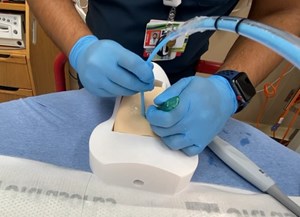
A call for awareness… DEI in Clinical Ultrasonography
Javier Rosario MD FACEP
University of Central Florida / HCA Healthcare GME (Greater Orlando)
There is growing evidence that racial disparities exist in the United States healthcare system. As it stands, underrepresented minorities make up 33% of the United States population.1 This underrepresentation continues through medical education, medical training programs, and academic centers.2-4 These inequities can have profound effects on attrition rates and faculty development, but more importantly they can exacerbate racial health disparities. A key strategy to address this problem is to recruit more professionals from these underrepresented racial and ethnic backgrounds.5
The Clinical Ultrasound (CUS) community and ACEP EUS Section are hard at work to create a culture of inclusivity and highlight strategies to identify and correct these inequities. Three recent multi-societal manuscripts highlight these inequities and share actionable strategies to increase diversity, equity and inclusion (DEI) in our CUS subspecialty and emergency medicine in general.6-8
Recruitment and Retention
Recruitment, retention, and advancement of UIM faculty are critical to increasing diversity, equity, and high-quality clinical care and is likely the main driver of change in medicine.8 This is where we believe lies the power to move the needle towards an increase in diversity. Leaders in the field should use their leverage to promote academic inclusivity and diversity. CUS leaders should be aware of the communities they serve and use this knowledge to recruit and retain faculty and/or fellows who resemble their community.
Reporting
There is currently no formal racial-ethnic data being collected on the CUS community. One recommendation is for national CUS organizations to collect and share data on underrepresented faculty and fellow speaking opportunities, leadership roles, and promotion. Accessible data can help identify inequalities and organize corrective action.6
References
- U.S. Census Bureau (2011). QuickFacts United States Population.
- Association of American Medical Colleges. Underrepresented in Medicine Definition; Initiatives; AAMC [Internet]. 2004.
- Association of American Medical Colleges. Diversity in Medicine: Facts and Figures 2019; Data & Reports; AAMC [Internet]. 2019.
- Association of American Medical Colleges. Report on Residents: Number of Active MD Residents, by Race/Ethnicity (Alone or In Combination) and GME Specialty; Data & Reports; AAMC [Internet]. 2020.
- Institute of Medicine (US) Committee on Institutional and Policy-Level Strategies for Increasing the Diversity of the U.S. Healthcare Workforce, Smedley BD, Stith Butler A, Bristow LR, eds. In the Nation's Compelling Interest: Ensuring Diversity in the Health-Care Workforce. Washington (DC): National Academies Press (US); 2004.
- Rosario J, Lewiss RE, Stolz LA, et al. Creating a more racial-ethnic inclusive clinical ultrasound community. Am J Emerg Med. 2022;54:208-211. doi:10.1016/j.ajem.2022.02.015
- Dessie AS, Lewiss RE, Stolz LA, et al. The state of gender inclusion in the point-of-care ultrasound community. Am J Emerg Med. 2022;56:283-285. doi:10.1016/j.ajem.2021.07.021
- Davenport D, Alvarez A, Natesan S, Caldwell MT, Gallegos M, Landry A, Parsons M, Gottlieb M. Faculty recruitment, retention, and representation in leadership: An evidence-based guide to best practices for diversity, equity, and inclusion from the Council of Residency Directors in Emergency Medicine. West J Emerg Med. 2022;23(1):62-71.



